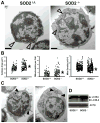Elevated mitochondrial superoxide disrupts normal T cell development, impairing adaptive immune responses to an influenza challenge
- PMID: 21130157
- PMCID: PMC3026081
- DOI: 10.1016/j.freeradbiomed.2010.11.025
Elevated mitochondrial superoxide disrupts normal T cell development, impairing adaptive immune responses to an influenza challenge
Abstract
Reactive oxygen species (ROS) are critical in a broad spectrum of cellular processes including signaling, tumor progression, and innate immunity. The essential nature of ROS signaling in the immune systems of Drosophila and zebrafish has been demonstrated; however, the role of ROS, if any, in mammalian adaptive immune system development and function remains unknown. This work provides the first clear demonstration that thymus-specific elevation of mitochondrial superoxide (O(2)(•-)) disrupts normal T cell development and impairs the function of the mammalian adaptive immune system. To assess the effect of elevated mitochondrial superoxide in the developing thymus, we used a T-cell-specific knockout of manganese superoxide dismutase (i.e., SOD2) and have thus established a murine model to examine the role of mitochondrial superoxide in T cell development. Conditional loss of SOD2 led to increased superoxide, apoptosis, and developmental defects in the T cell population, resulting in immunodeficiency and susceptibility to the influenza A virus H1N1. This phenotype was rescued with mitochondrially targeted superoxide-scavenging drugs. These findings demonstrate that loss of regulated levels of mitochondrial superoxide lead to aberrant T cell development and function, and further suggest that manipulations of mitochondrial superoxide levels may significantly alter clinical outcomes resulting from viral infection.
Copyright © 2010 Elsevier Inc. All rights reserved.
Conflict of interest statement
The authors have no conflicts of interest to disclose on this research project
Figures






References
-
- McCord JM, Fridovich I. The biology and pathology of oxygen radicals. Ann Intern Med. 1978;89:122–127. - PubMed
-
- Cerutti PA. Prooxidant states and tumor promotion. Science. 1985;227:375–381. - PubMed
-
- Fridovich I. Oxygen toxicity: a radical explanation. J Exp Biol. 1998;201:1203–1209. - PubMed
-
- Leibovitz BE, Siegel BV. Aspects of free radical reactions in biological systems: aging. J Gerontol. 1980;35:45–56. - PubMed
Publication types
MeSH terms
Substances
Grants and funding
LinkOut - more resources
Full Text Sources
Other Literature Sources
Molecular Biology Databases

